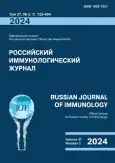О связи между уровнями мочевой кислоты в сыворотке крови и функциональной активностью комплемента
- Авторы: Бельтюков П.П.1, Токарев А.Ю.1, Смирнова А.С.1, Бельтюкова М.Е.2
-
Учреждения:
- ФГУП «Научно-исследовательский институт гигиены, профпатологии и экологии человека» ФМБА России
- ФГБУ «Национальный медицинский исследовательский центр имени В.А. Алмазова» Министерства здравоохранения РФ
- Выпуск: Том 27, № 2 (2024)
- Страницы: 369-374
- Раздел: КРАТКИЕ СООБЩЕНИЯ
- URL: https://journals.rcsi.science/1028-7221/article/view/263701
- DOI: https://doi.org/10.46235/1028-7221-16800-TRB
- ID: 263701
Цитировать
Полный текст
Аннотация
Мочевая кислота является конечным продуктом обмена пуриновых нуклеотидов и веществом, способствующим развитию хронического воспалительного процесса. Одним из механизмов развития воспаления, связанного с действием мочевой кислоты, является способность кристаллов ее солей, в основном мононатриевой соли, активировать инфламмасомы NLRP3. На этом основании мочевая кислота и кристаллы ее солей отнесены к молекулярным паттернам, связанным с повреждением (DAMP). К эффектам кристаллов солей мочевой кислоты, связанных с ответом иммунной системы, относится и их способность активировать систему комплемента. Результатом такой активации становится повышение концентраций С3а, С4а и С5а, а также избыточное расходование белков системы комплемента. Несмотря на то, что о способности мочевой кислоты активировать систему комплемента известно давно, сведения о связи гиперурикемии и функциональной активности комплемента, которую можно оценить по комплемент-опосредованному гемолизу в литературе отсутствуют. Поэтому обоснование предельной концентрации мочевой кислоты в крови, не приводящей к спонтанной активации системы комплемента, является актуальным вопросом. В настоящем исследовании предпринята попытка установить предельные концентрации мочевой кислоты, которые не оказывают эффекта на функциональную активность комплемента, оцененную по параметрам комплемент-опосредованного гемолиза. В ходе исследования оценены взаимосвязи между параметрами функциональной активности комплемента и некоторыми биохимическими показателями крови с концентрацией мочевой кислоты методами корреляционного анализа. В качестве показателей функциональной активности комплемента рассматривали скорость (Vlys) и время 50%-ного гемолиза (T50). Взаимосвязи между исследованными показателями удалось продемонстрировать с использованием показательной функции y = a*e[x], которая в данном случае принимает вид y = [МК]*e[C3]. Аргументом функции является концентрация C3, основание степени равно основанию натурального логарифма, а коэффициент пропорциональности равен концентрации мочевой кислоты. Как оказалось, значения данной функции находятся в обратной зависимости от соответствующих значений T50 (r = 0,83, p < 0,0001) в диапазоне концентрации мочевой кислоты, превышающей 370 мкМ. Это значение концентрации мочевой кислоты почти равно верхней границе нормы для женщин и находится в пределах диапазона нормы для мужчин. Таким образом, подход к оценке роли мочевой кислоты в активации комплемента с использованием анализа параметров комплемент-опосредованного гемолиза эффективен для демонстрации патогенетической функции мочевой кислоты в развитии воспалительного процесса без вовлечения инфламмасом путем прямого воздействия на процессы активации комплемента. По нашему мнению, этот эффект реализуется главным образом за счет альтернативного пути комплемента. Продемонстрированные связи позволяют говорить об условности верхних границ диапазона нормальных концентраций мочевой кислоты и вероятной целесообразности их пересмотра.
Ключевые слова
Полный текст
Открыть статью на сайте журналаОб авторах
П. П. Бельтюков
ФГУП «Научно-исследовательский институт гигиены, профпатологии и экологии человека» ФМБА России
Автор, ответственный за переписку.
Email: biochem2005@rambler.ru
к.м.н., доцент, ведущий научный сотрудник лаборатории молекулярной токсикологии и экспериментальной терапии
Россия, Ленинградская обл.А. Ю. Токарев
ФГУП «Научно-исследовательский институт гигиены, профпатологии и экологии человека» ФМБА России
Email: biochem2005@rambler.ru
научный сотрудник лаборатории молекулярной токсикологии и экспериментальной терапии
Россия, Ленинградская обл.А. С. Смирнова
ФГУП «Научно-исследовательский институт гигиены, профпатологии и экологии человека» ФМБА России
Email: biochem2005@rambler.ru
младший научный сотрудник лаборатории молекулярной токсикологии и экспериментальной терапии
Россия, Ленинградская обл.М. Е. Бельтюкова
ФГБУ «Национальный медицинский исследовательский центр имени В.А. Алмазова» Министерства здравоохранения РФ
Email: biochem2005@rambler.ru
врач клинико-диагностической лаборатории лечебно-реабилитационного центра
Россия, Санкт-ПетербургСписок литературы
- Braga T.T., Forni M.F., Correa-Costa M., Ramos R.N., Barbuto J.A., Branco P., Castoldi A., Hiyane M.I., Davanso M.R., Latz E., Franklin B.S., Kowaltowski A.J., Camara N.O. Soluble uric acid activates the NLRP3 Inflammasome. Sci. Rep., 2017, Vol. 7, 39884. doi: 10.1038/srep39884.
- Kippen I., Klinenberg J.R., Weinberger A., Wilcox W.R. Factors affecting urate solubility in vitro. Ann. Rheum. Dis., 1974, Vol. 33, no. 4, pp. 313-317.
- Lobo J.C., Lucas A.C., da Nóbrega A., Carraro-Eduardo J.C., Mafra D. Uric acid levels correlates with inflammatory markers and adhesion molecules in hemodialysis patients. Kidney Res. Clin. Pract., 2012, Vol. 31, no. 2, A53. doi: 10.1016/j.krcp.2012.04.472.
- Russell I.J., Papaioannou C., McDuffie F.C., MacIntyre S., Kushner I. Effect of IgG and C-reactive protein on complement depletion by monosodium urate crystals. J. Rheumatol., 1983, Vol. 10, no. 3, pp. 425-433.
- Wessig A.K., Hoffmeister L., Klingberg A., Alberts A., Pich A., Brand K., Witte T., Neumann K. Natural antibodies and CRP drive anaphylatoxin production by urate crystals. Sci. Rep., 2022, Vol. 12, no. 1, 4483. doi: 10.1038/s41598-022-08311-z.
Дополнительные файлы








